Innovation and Commercialisation in Organisations: Detailed Analysis
VerifiedAdded on 2024/05/29
|25
|5190
|388
Report
AI Summary
This report provides a comprehensive analysis of innovation and commercialisation within organisations, focusing on Wiser as a case study. It distinguishes between invention and innovation, explores how organisational vision, leadership, culture, and teamwork shape innovation, and analyses various sources of innovation. The report also examines the 4Ps of innovation, the innovation funnel, and the role of frugal innovation. Furthermore, it discusses the commercialisation process, the importance of new product development, and methods for protecting ideas and intellectual property. The analysis includes building an innovation business case and evaluating tools for developing and retaining knowledge, concluding with an assessment of how organisations can overcome challenges to achieve successful innovations. Desklib provides access to similar solved assignments and past papers for students.

INNOVATION AND COMMERCIALISATION IN ORGANISATION
Paraphrase This Document
Need a fresh take? Get an instant paraphrase of this document with our AI Paraphraser
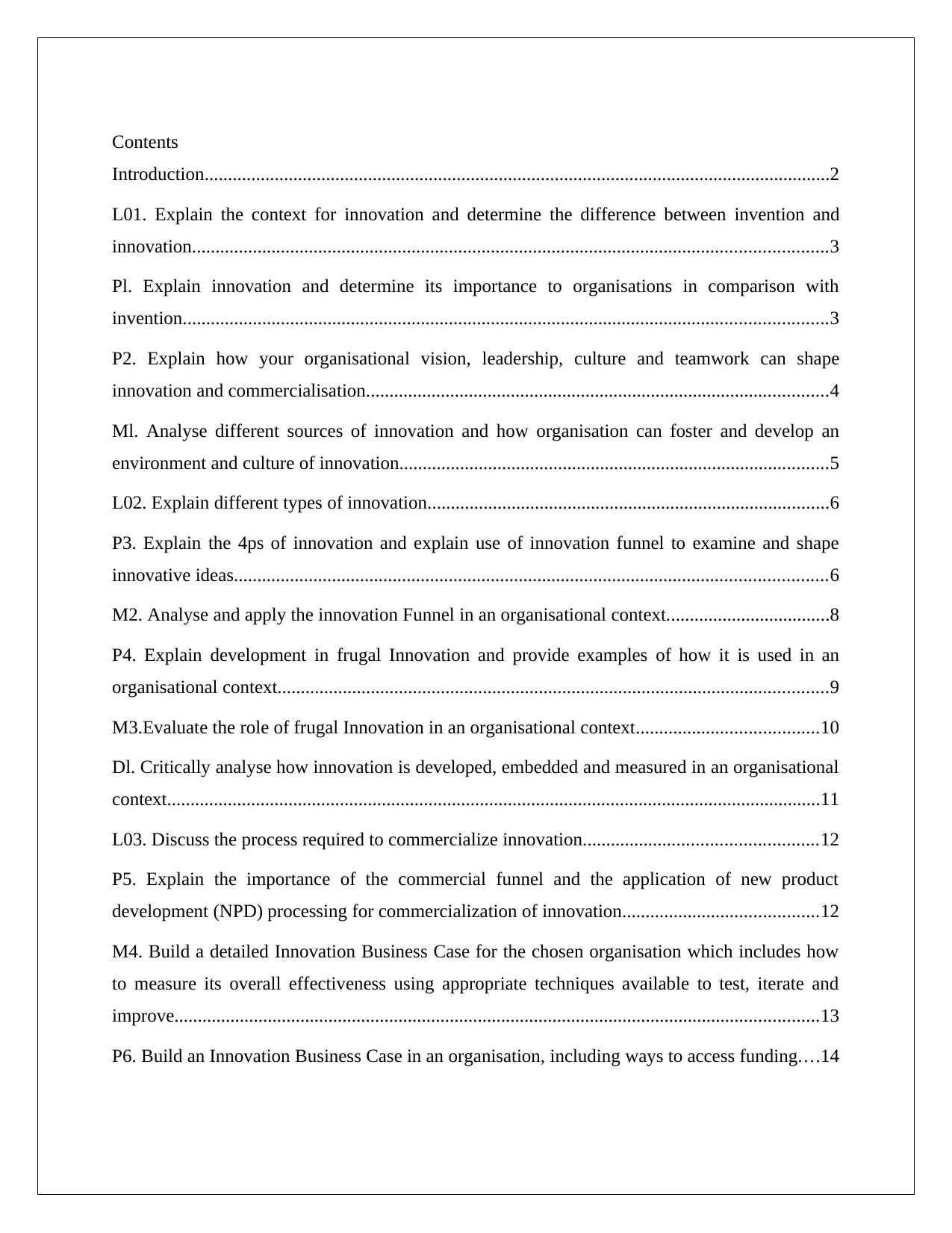
Contents
Introduction......................................................................................................................................2
L01. Explain the context for innovation and determine the difference between invention and
innovation........................................................................................................................................3
Pl. Explain innovation and determine its importance to organisations in comparison with
invention..........................................................................................................................................3
P2. Explain how your organisational vision, leadership, culture and teamwork can shape
innovation and commercialisation...................................................................................................4
Ml. Analyse different sources of innovation and how organisation can foster and develop an
environment and culture of innovation............................................................................................5
L02. Explain different types of innovation......................................................................................6
P3. Explain the 4ps of innovation and explain use of innovation funnel to examine and shape
innovative ideas...............................................................................................................................6
M2. Analyse and apply the innovation Funnel in an organisational context...................................8
P4. Explain development in frugal Innovation and provide examples of how it is used in an
organisational context......................................................................................................................9
M3.Evaluate the role of frugal Innovation in an organisational context.......................................10
Dl. Critically analyse how innovation is developed, embedded and measured in an organisational
context............................................................................................................................................11
L03. Discuss the process required to commercialize innovation..................................................12
P5. Explain the importance of the commercial funnel and the application of new product
development (NPD) processing for commercialization of innovation..........................................12
M4. Build a detailed Innovation Business Case for the chosen organisation which includes how
to measure its overall effectiveness using appropriate techniques available to test, iterate and
improve..........................................................................................................................................13
P6. Build an Innovation Business Case in an organisation, including ways to access funding....14
Introduction......................................................................................................................................2
L01. Explain the context for innovation and determine the difference between invention and
innovation........................................................................................................................................3
Pl. Explain innovation and determine its importance to organisations in comparison with
invention..........................................................................................................................................3
P2. Explain how your organisational vision, leadership, culture and teamwork can shape
innovation and commercialisation...................................................................................................4
Ml. Analyse different sources of innovation and how organisation can foster and develop an
environment and culture of innovation............................................................................................5
L02. Explain different types of innovation......................................................................................6
P3. Explain the 4ps of innovation and explain use of innovation funnel to examine and shape
innovative ideas...............................................................................................................................6
M2. Analyse and apply the innovation Funnel in an organisational context...................................8
P4. Explain development in frugal Innovation and provide examples of how it is used in an
organisational context......................................................................................................................9
M3.Evaluate the role of frugal Innovation in an organisational context.......................................10
Dl. Critically analyse how innovation is developed, embedded and measured in an organisational
context............................................................................................................................................11
L03. Discuss the process required to commercialize innovation..................................................12
P5. Explain the importance of the commercial funnel and the application of new product
development (NPD) processing for commercialization of innovation..........................................12
M4. Build a detailed Innovation Business Case for the chosen organisation which includes how
to measure its overall effectiveness using appropriate techniques available to test, iterate and
improve..........................................................................................................................................13
P6. Build an Innovation Business Case in an organisation, including ways to access funding....14
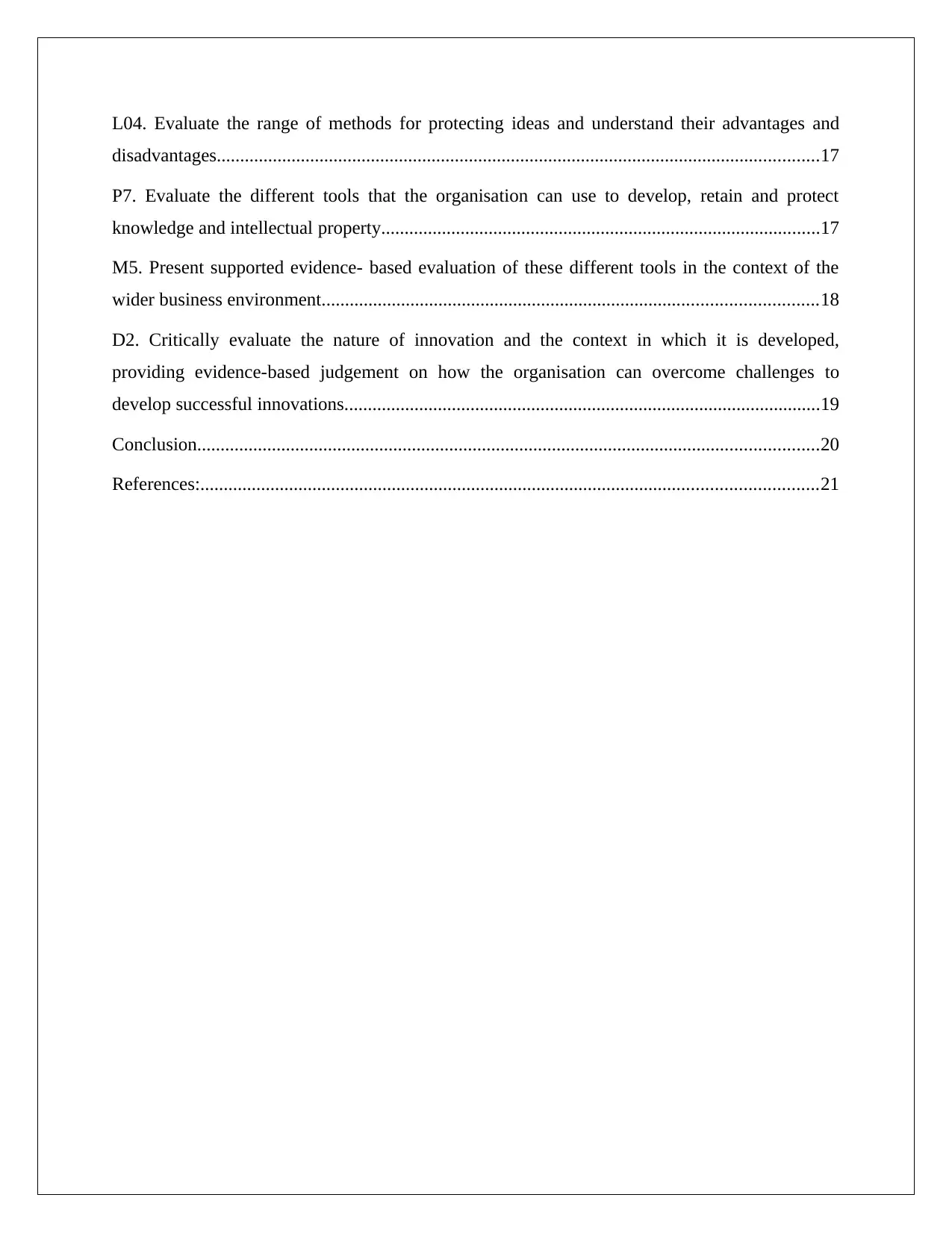
L04. Evaluate the range of methods for protecting ideas and understand their advantages and
disadvantages.................................................................................................................................17
P7. Evaluate the different tools that the organisation can use to develop, retain and protect
knowledge and intellectual property..............................................................................................17
M5. Present supported evidence- based evaluation of these different tools in the context of the
wider business environment..........................................................................................................18
D2. Critically evaluate the nature of innovation and the context in which it is developed,
providing evidence-based judgement on how the organisation can overcome challenges to
develop successful innovations......................................................................................................19
Conclusion.....................................................................................................................................20
References:....................................................................................................................................21
disadvantages.................................................................................................................................17
P7. Evaluate the different tools that the organisation can use to develop, retain and protect
knowledge and intellectual property..............................................................................................17
M5. Present supported evidence- based evaluation of these different tools in the context of the
wider business environment..........................................................................................................18
D2. Critically evaluate the nature of innovation and the context in which it is developed,
providing evidence-based judgement on how the organisation can overcome challenges to
develop successful innovations......................................................................................................19
Conclusion.....................................................................................................................................20
References:....................................................................................................................................21
⊘ This is a preview!⊘
Do you want full access?
Subscribe today to unlock all pages.

Trusted by 1+ million students worldwide
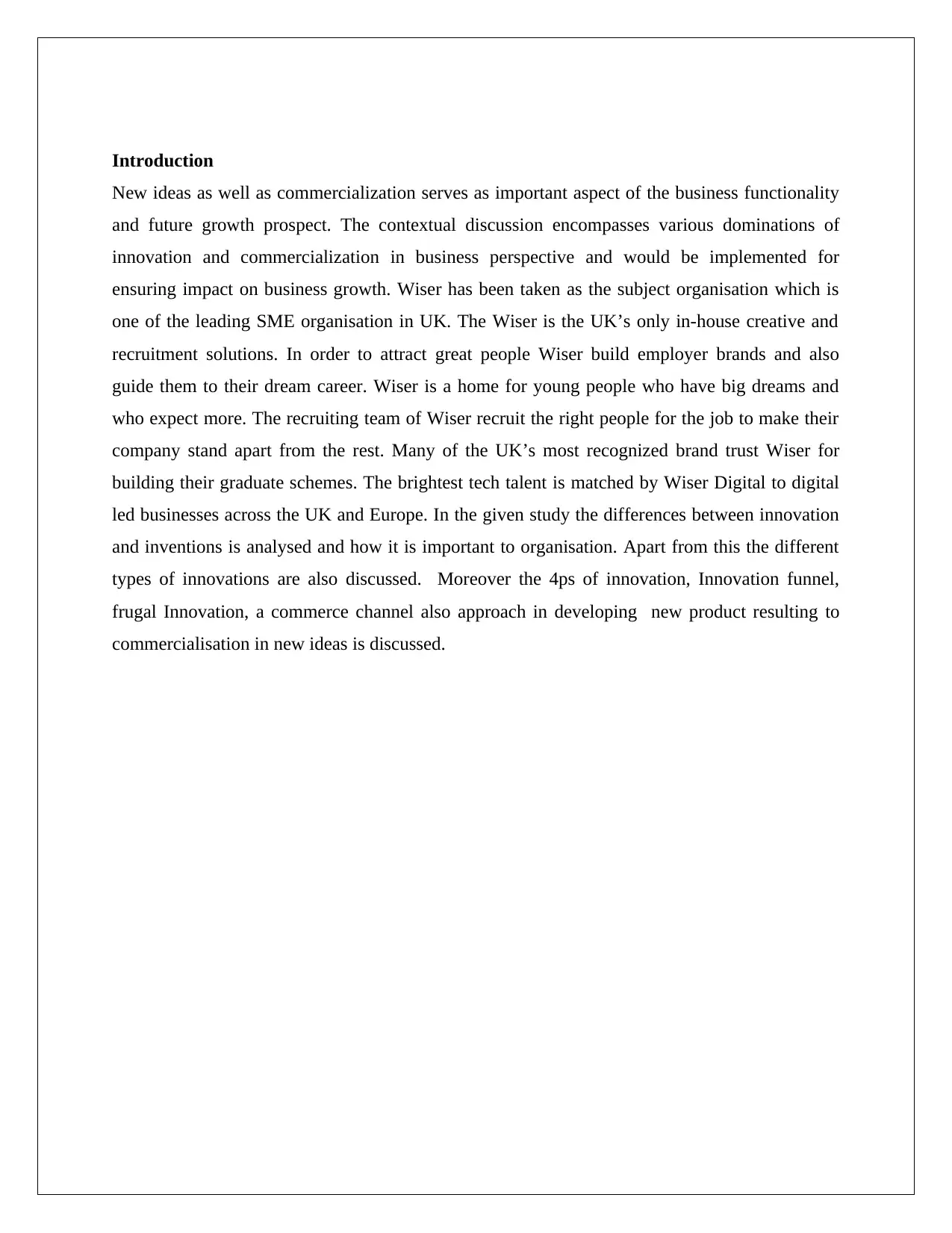
Introduction
New ideas as well as commercialization serves as important aspect of the business functionality
and future growth prospect. The contextual discussion encompasses various dominations of
innovation and commercialization in business perspective and would be implemented for
ensuring impact on business growth. Wiser has been taken as the subject organisation which is
one of the leading SME organisation in UK. The Wiser is the UK’s only in-house creative and
recruitment solutions. In order to attract great people Wiser build employer brands and also
guide them to their dream career. Wiser is a home for young people who have big dreams and
who expect more. The recruiting team of Wiser recruit the right people for the job to make their
company stand apart from the rest. Many of the UK’s most recognized brand trust Wiser for
building their graduate schemes. The brightest tech talent is matched by Wiser Digital to digital
led businesses across the UK and Europe. In the given study the differences between innovation
and inventions is analysed and how it is important to organisation. Apart from this the different
types of innovations are also discussed. Moreover the 4ps of innovation, Innovation funnel,
frugal Innovation, a commerce channel also approach in developing new product resulting to
commercialisation in new ideas is discussed.
New ideas as well as commercialization serves as important aspect of the business functionality
and future growth prospect. The contextual discussion encompasses various dominations of
innovation and commercialization in business perspective and would be implemented for
ensuring impact on business growth. Wiser has been taken as the subject organisation which is
one of the leading SME organisation in UK. The Wiser is the UK’s only in-house creative and
recruitment solutions. In order to attract great people Wiser build employer brands and also
guide them to their dream career. Wiser is a home for young people who have big dreams and
who expect more. The recruiting team of Wiser recruit the right people for the job to make their
company stand apart from the rest. Many of the UK’s most recognized brand trust Wiser for
building their graduate schemes. The brightest tech talent is matched by Wiser Digital to digital
led businesses across the UK and Europe. In the given study the differences between innovation
and inventions is analysed and how it is important to organisation. Apart from this the different
types of innovations are also discussed. Moreover the 4ps of innovation, Innovation funnel,
frugal Innovation, a commerce channel also approach in developing new product resulting to
commercialisation in new ideas is discussed.
Paraphrase This Document
Need a fresh take? Get an instant paraphrase of this document with our AI Paraphraser
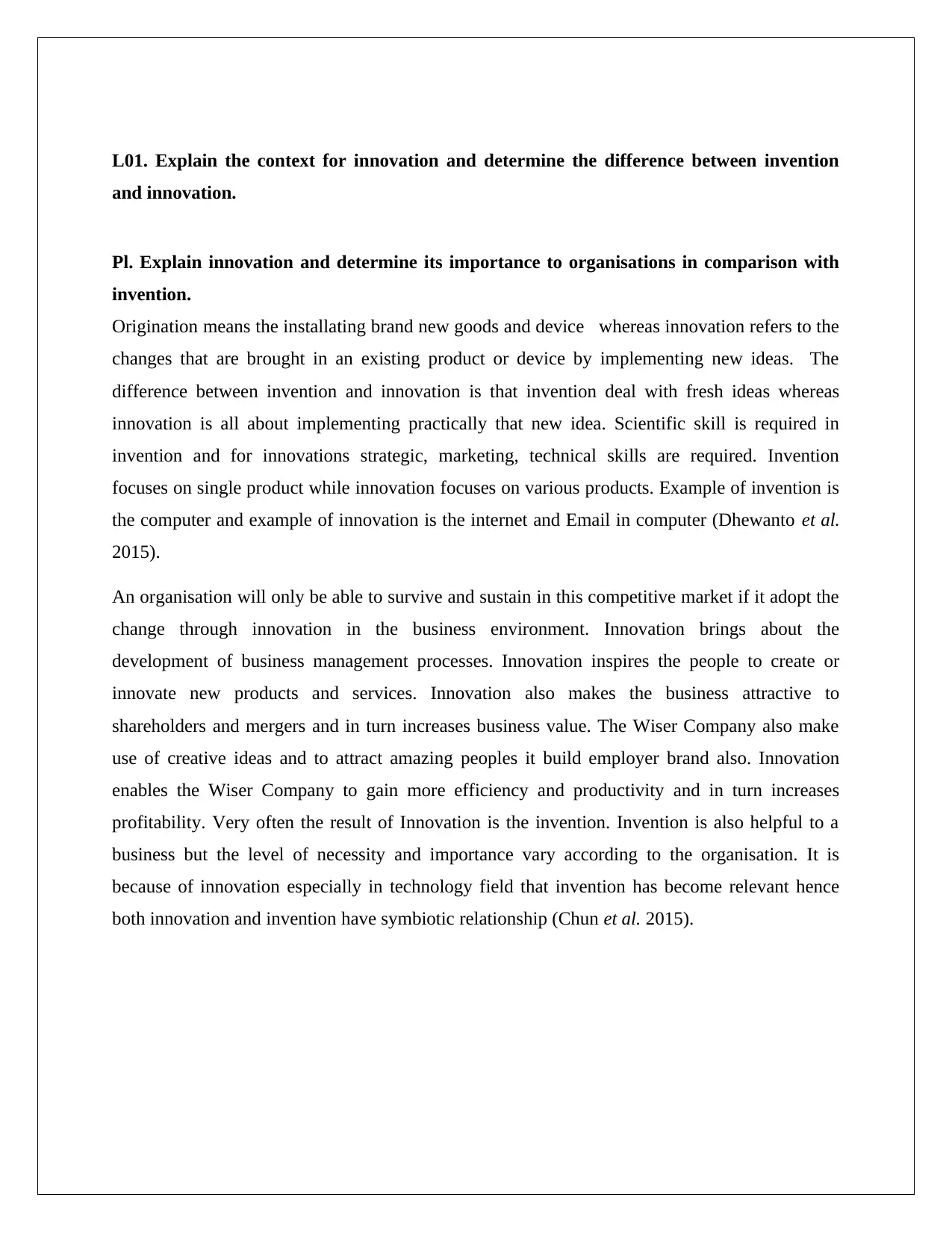
L01. Explain the context for innovation and determine the difference between invention
and innovation.
Pl. Explain innovation and determine its importance to organisations in comparison with
invention.
Origination means the installating brand new goods and device whereas innovation refers to the
changes that are brought in an existing product or device by implementing new ideas. The
difference between invention and innovation is that invention deal with fresh ideas whereas
innovation is all about implementing practically that new idea. Scientific skill is required in
invention and for innovations strategic, marketing, technical skills are required. Invention
focuses on single product while innovation focuses on various products. Example of invention is
the computer and example of innovation is the internet and Email in computer (Dhewanto et al.
2015).
An organisation will only be able to survive and sustain in this competitive market if it adopt the
change through innovation in the business environment. Innovation brings about the
development of business management processes. Innovation inspires the people to create or
innovate new products and services. Innovation also makes the business attractive to
shareholders and mergers and in turn increases business value. The Wiser Company also make
use of creative ideas and to attract amazing peoples it build employer brand also. Innovation
enables the Wiser Company to gain more efficiency and productivity and in turn increases
profitability. Very often the result of Innovation is the invention. Invention is also helpful to a
business but the level of necessity and importance vary according to the organisation. It is
because of innovation especially in technology field that invention has become relevant hence
both innovation and invention have symbiotic relationship (Chun et al. 2015).
and innovation.
Pl. Explain innovation and determine its importance to organisations in comparison with
invention.
Origination means the installating brand new goods and device whereas innovation refers to the
changes that are brought in an existing product or device by implementing new ideas. The
difference between invention and innovation is that invention deal with fresh ideas whereas
innovation is all about implementing practically that new idea. Scientific skill is required in
invention and for innovations strategic, marketing, technical skills are required. Invention
focuses on single product while innovation focuses on various products. Example of invention is
the computer and example of innovation is the internet and Email in computer (Dhewanto et al.
2015).
An organisation will only be able to survive and sustain in this competitive market if it adopt the
change through innovation in the business environment. Innovation brings about the
development of business management processes. Innovation inspires the people to create or
innovate new products and services. Innovation also makes the business attractive to
shareholders and mergers and in turn increases business value. The Wiser Company also make
use of creative ideas and to attract amazing peoples it build employer brand also. Innovation
enables the Wiser Company to gain more efficiency and productivity and in turn increases
profitability. Very often the result of Innovation is the invention. Invention is also helpful to a
business but the level of necessity and importance vary according to the organisation. It is
because of innovation especially in technology field that invention has become relevant hence
both innovation and invention have symbiotic relationship (Chun et al. 2015).

P2. Explain how your organisational vision, leadership, culture and teamwork can shape
innovation and commercialisation.
Picture. A process involve in launching innovative goods in the market which is easily accessible
by a customer in commerce is called commercialization. An organisational vision is the desired
future position of the company. Vision is long term plan formulated by the company to achieve
desired objectives.
Leadership: Without an efficient leadership Innovation cannot succeed. The tone is set by the
leader and on this tone the workers work to achieve the objective of an organisation.
Organisational culture: Organisational culture is the beliefs and values that exist in an
organisation. If there is well thought out strategies and strong execution then only in the
industrial economy that organization is said to be efficient. It is up to the leaders and their
teamwork to move forward in order to allow for Organisational innovation and its vision. The
leadership plays an important role to achieve the organisational vision. The innovative leaders
has a vision of the future. The innovative leaders are capable of developing trust in their
employees. Aspirational goals are set by the leaders for his team keeping in mind organisational
vision and culture which inspires the employees to work efficiently. The drive of the effective
leaders creates innovation culture and leads to the path of commercialization. When the
cooperation between leadership and employees is good then the organisational culture make a
great contribution to team communication and encourage the team to accomplish the
organisation vision (Polson et al. 2016).
innovation and commercialisation.
Picture. A process involve in launching innovative goods in the market which is easily accessible
by a customer in commerce is called commercialization. An organisational vision is the desired
future position of the company. Vision is long term plan formulated by the company to achieve
desired objectives.
Leadership: Without an efficient leadership Innovation cannot succeed. The tone is set by the
leader and on this tone the workers work to achieve the objective of an organisation.
Organisational culture: Organisational culture is the beliefs and values that exist in an
organisation. If there is well thought out strategies and strong execution then only in the
industrial economy that organization is said to be efficient. It is up to the leaders and their
teamwork to move forward in order to allow for Organisational innovation and its vision. The
leadership plays an important role to achieve the organisational vision. The innovative leaders
has a vision of the future. The innovative leaders are capable of developing trust in their
employees. Aspirational goals are set by the leaders for his team keeping in mind organisational
vision and culture which inspires the employees to work efficiently. The drive of the effective
leaders creates innovation culture and leads to the path of commercialization. When the
cooperation between leadership and employees is good then the organisational culture make a
great contribution to team communication and encourage the team to accomplish the
organisation vision (Polson et al. 2016).
⊘ This is a preview!⊘
Do you want full access?
Subscribe today to unlock all pages.

Trusted by 1+ million students worldwide
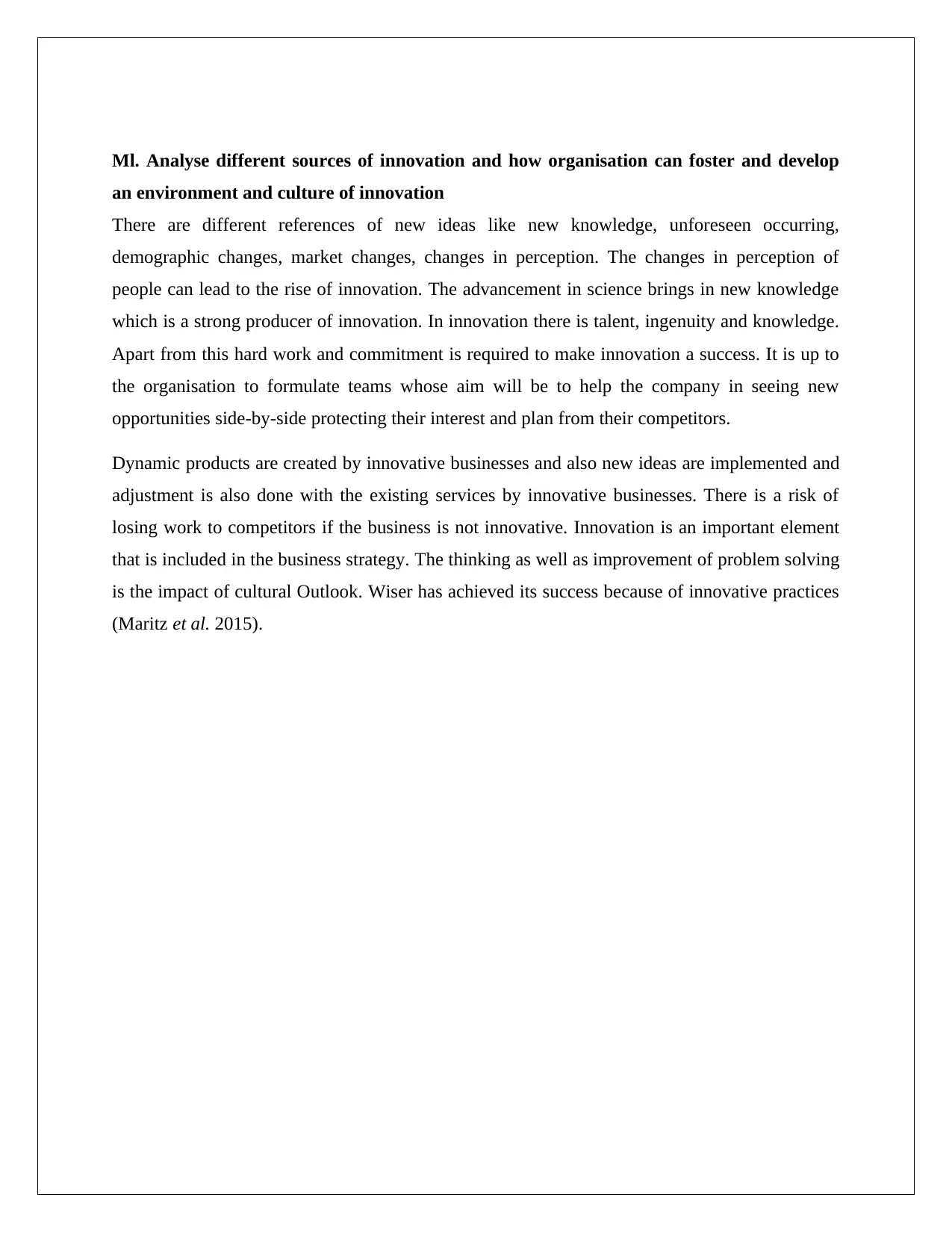
Ml. Analyse different sources of innovation and how organisation can foster and develop
an environment and culture of innovation
There are different references of new ideas like new knowledge, unforeseen occurring,
demographic changes, market changes, changes in perception. The changes in perception of
people can lead to the rise of innovation. The advancement in science brings in new knowledge
which is a strong producer of innovation. In innovation there is talent, ingenuity and knowledge.
Apart from this hard work and commitment is required to make innovation a success. It is up to
the organisation to formulate teams whose aim will be to help the company in seeing new
opportunities side-by-side protecting their interest and plan from their competitors.
Dynamic products are created by innovative businesses and also new ideas are implemented and
adjustment is also done with the existing services by innovative businesses. There is a risk of
losing work to competitors if the business is not innovative. Innovation is an important element
that is included in the business strategy. The thinking as well as improvement of problem solving
is the impact of cultural Outlook. Wiser has achieved its success because of innovative practices
(Maritz et al. 2015).
an environment and culture of innovation
There are different references of new ideas like new knowledge, unforeseen occurring,
demographic changes, market changes, changes in perception. The changes in perception of
people can lead to the rise of innovation. The advancement in science brings in new knowledge
which is a strong producer of innovation. In innovation there is talent, ingenuity and knowledge.
Apart from this hard work and commitment is required to make innovation a success. It is up to
the organisation to formulate teams whose aim will be to help the company in seeing new
opportunities side-by-side protecting their interest and plan from their competitors.
Dynamic products are created by innovative businesses and also new ideas are implemented and
adjustment is also done with the existing services by innovative businesses. There is a risk of
losing work to competitors if the business is not innovative. Innovation is an important element
that is included in the business strategy. The thinking as well as improvement of problem solving
is the impact of cultural Outlook. Wiser has achieved its success because of innovative practices
(Maritz et al. 2015).
Paraphrase This Document
Need a fresh take? Get an instant paraphrase of this document with our AI Paraphraser
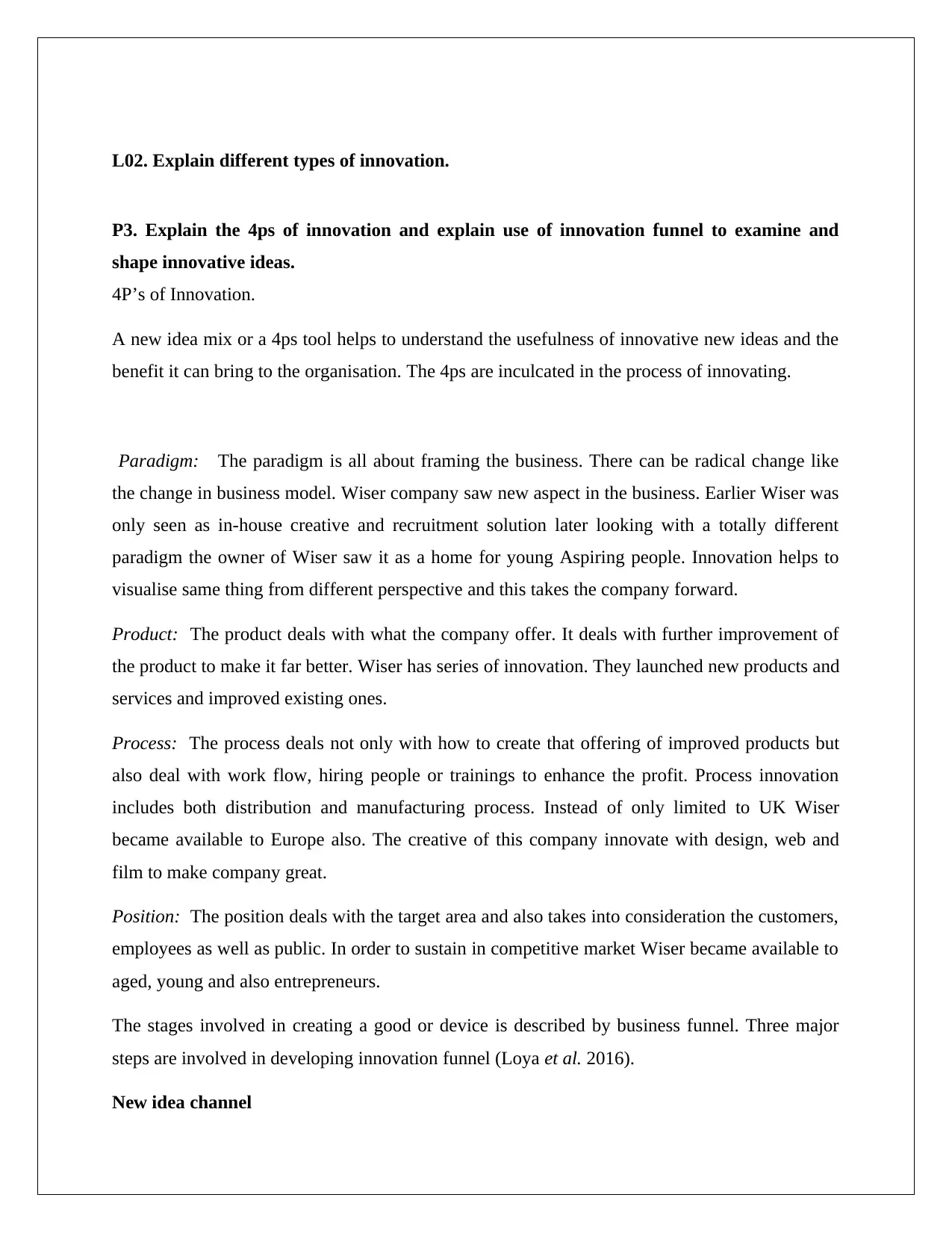
L02. Explain different types of innovation.
P3. Explain the 4ps of innovation and explain use of innovation funnel to examine and
shape innovative ideas.
4P’s of Innovation.
A new idea mix or a 4ps tool helps to understand the usefulness of innovative new ideas and the
benefit it can bring to the organisation. The 4ps are inculcated in the process of innovating.
Paradigm: The paradigm is all about framing the business. There can be radical change like
the change in business model. Wiser company saw new aspect in the business. Earlier Wiser was
only seen as in-house creative and recruitment solution later looking with a totally different
paradigm the owner of Wiser saw it as a home for young Aspiring people. Innovation helps to
visualise same thing from different perspective and this takes the company forward.
Product: The product deals with what the company offer. It deals with further improvement of
the product to make it far better. Wiser has series of innovation. They launched new products and
services and improved existing ones.
Process: The process deals not only with how to create that offering of improved products but
also deal with work flow, hiring people or trainings to enhance the profit. Process innovation
includes both distribution and manufacturing process. Instead of only limited to UK Wiser
became available to Europe also. The creative of this company innovate with design, web and
film to make company great.
Position: The position deals with the target area and also takes into consideration the customers,
employees as well as public. In order to sustain in competitive market Wiser became available to
aged, young and also entrepreneurs.
The stages involved in creating a good or device is described by business funnel. Three major
steps are involved in developing innovation funnel (Loya et al. 2016).
New idea channel
P3. Explain the 4ps of innovation and explain use of innovation funnel to examine and
shape innovative ideas.
4P’s of Innovation.
A new idea mix or a 4ps tool helps to understand the usefulness of innovative new ideas and the
benefit it can bring to the organisation. The 4ps are inculcated in the process of innovating.
Paradigm: The paradigm is all about framing the business. There can be radical change like
the change in business model. Wiser company saw new aspect in the business. Earlier Wiser was
only seen as in-house creative and recruitment solution later looking with a totally different
paradigm the owner of Wiser saw it as a home for young Aspiring people. Innovation helps to
visualise same thing from different perspective and this takes the company forward.
Product: The product deals with what the company offer. It deals with further improvement of
the product to make it far better. Wiser has series of innovation. They launched new products and
services and improved existing ones.
Process: The process deals not only with how to create that offering of improved products but
also deal with work flow, hiring people or trainings to enhance the profit. Process innovation
includes both distribution and manufacturing process. Instead of only limited to UK Wiser
became available to Europe also. The creative of this company innovate with design, web and
film to make company great.
Position: The position deals with the target area and also takes into consideration the customers,
employees as well as public. In order to sustain in competitive market Wiser became available to
aged, young and also entrepreneurs.
The stages involved in creating a good or device is described by business funnel. Three major
steps are involved in developing innovation funnel (Loya et al. 2016).
New idea channel
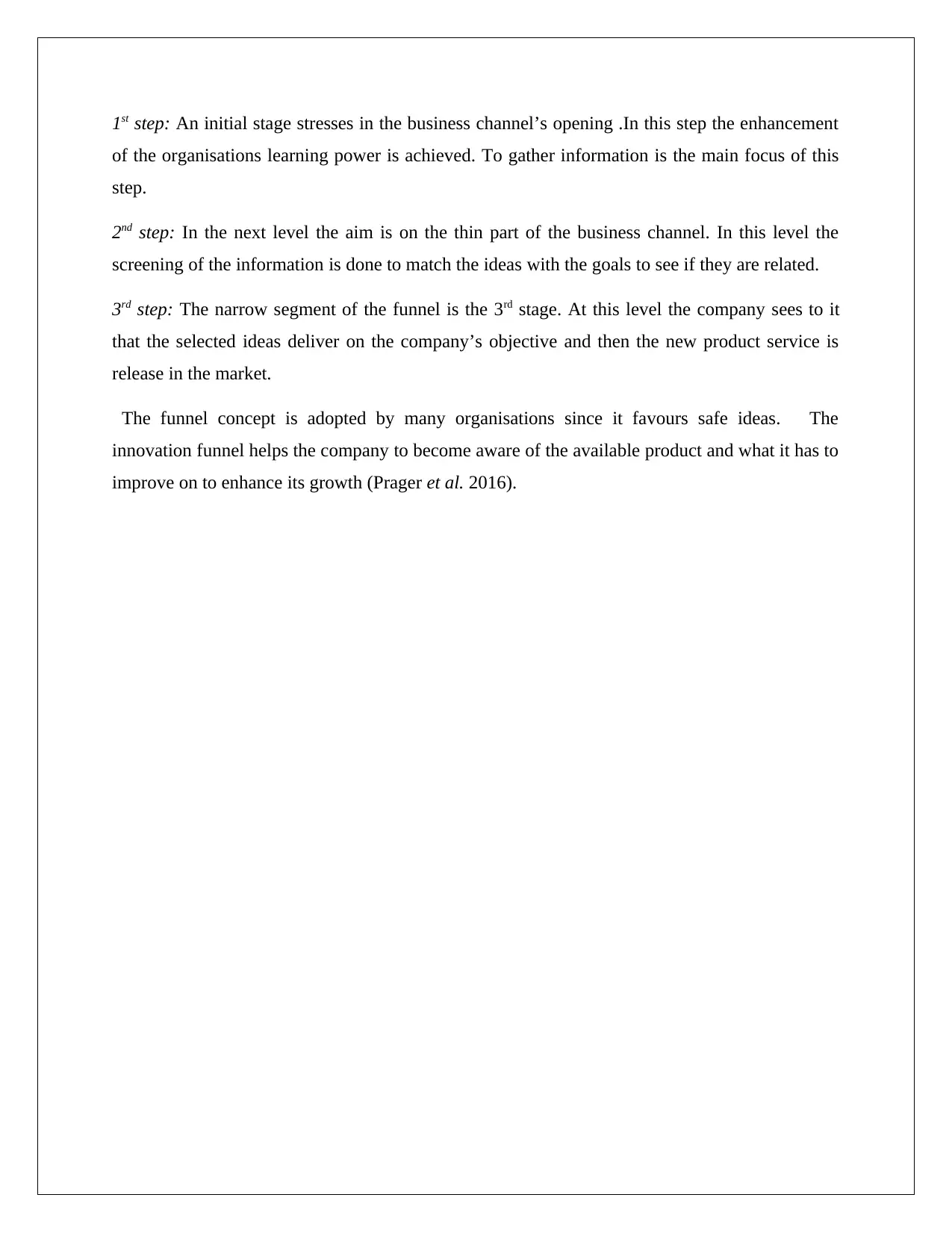
1st step: An initial stage stresses in the business channel’s opening .In this step the enhancement
of the organisations learning power is achieved. To gather information is the main focus of this
step.
2nd step: In the next level the aim is on the thin part of the business channel. In this level the
screening of the information is done to match the ideas with the goals to see if they are related.
3rd step: The narrow segment of the funnel is the 3rd stage. At this level the company sees to it
that the selected ideas deliver on the company’s objective and then the new product service is
release in the market.
The funnel concept is adopted by many organisations since it favours safe ideas. The
innovation funnel helps the company to become aware of the available product and what it has to
improve on to enhance its growth (Prager et al. 2016).
of the organisations learning power is achieved. To gather information is the main focus of this
step.
2nd step: In the next level the aim is on the thin part of the business channel. In this level the
screening of the information is done to match the ideas with the goals to see if they are related.
3rd step: The narrow segment of the funnel is the 3rd stage. At this level the company sees to it
that the selected ideas deliver on the company’s objective and then the new product service is
release in the market.
The funnel concept is adopted by many organisations since it favours safe ideas. The
innovation funnel helps the company to become aware of the available product and what it has to
improve on to enhance its growth (Prager et al. 2016).
⊘ This is a preview!⊘
Do you want full access?
Subscribe today to unlock all pages.

Trusted by 1+ million students worldwide
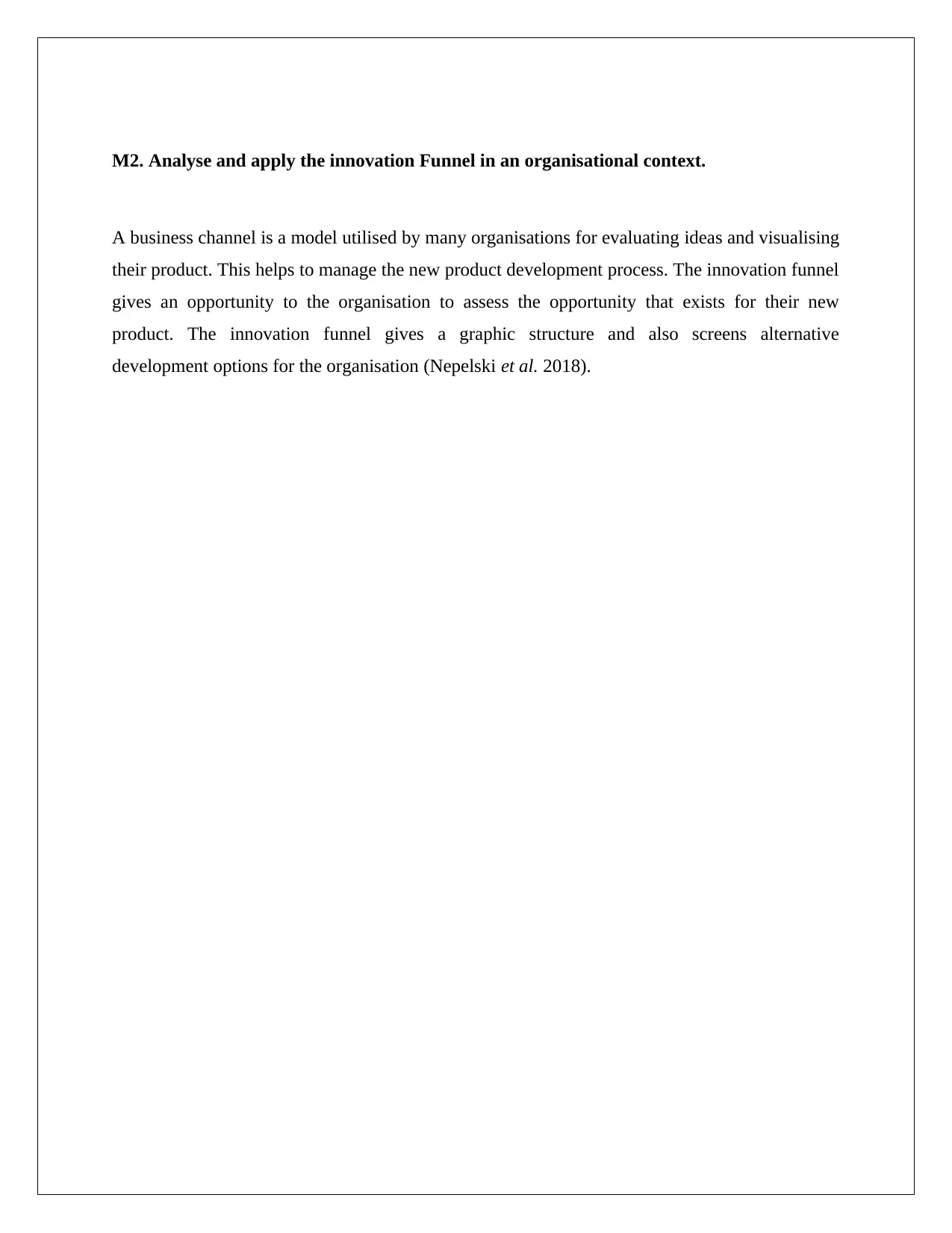
M2. Analyse and apply the innovation Funnel in an organisational context.
A business channel is a model utilised by many organisations for evaluating ideas and visualising
their product. This helps to manage the new product development process. The innovation funnel
gives an opportunity to the organisation to assess the opportunity that exists for their new
product. The innovation funnel gives a graphic structure and also screens alternative
development options for the organisation (Nepelski et al. 2018).
A business channel is a model utilised by many organisations for evaluating ideas and visualising
their product. This helps to manage the new product development process. The innovation funnel
gives an opportunity to the organisation to assess the opportunity that exists for their new
product. The innovation funnel gives a graphic structure and also screens alternative
development options for the organisation (Nepelski et al. 2018).
Paraphrase This Document
Need a fresh take? Get an instant paraphrase of this document with our AI Paraphraser

P4. Explain development in frugal Innovation and provide examples of how it is used in an
organisational context
The purpose to decrease cost and complexities dealing with goods manufacturing is called
economical invention. The functional solution through few resources is provided by the frugal
innovation for the organisation that has little means. The frugal innovation focussed on the lower
level and later moves upwards to profit everyone. This kind of innovation process which
debunks heavy R&D investment claims, it is also a resource constraint but it achieves
profitability. Frugal innovation emerges in emerging market of vast population but few resources
and the complex Institution. It is through frugal innovation that entrepreneurs fulfil local needs.
The frugal innovation helps to solve many problems at local and practical level. The frugal
innovation is adopted by the firm to give away their goods at reasonable cost. Consumers are the
poor classes. The firm develops this idea to decrease their expenses and cost of manufacturing
(Bhardwaj et al. 2015).
organisational context
The purpose to decrease cost and complexities dealing with goods manufacturing is called
economical invention. The functional solution through few resources is provided by the frugal
innovation for the organisation that has little means. The frugal innovation focussed on the lower
level and later moves upwards to profit everyone. This kind of innovation process which
debunks heavy R&D investment claims, it is also a resource constraint but it achieves
profitability. Frugal innovation emerges in emerging market of vast population but few resources
and the complex Institution. It is through frugal innovation that entrepreneurs fulfil local needs.
The frugal innovation helps to solve many problems at local and practical level. The frugal
innovation is adopted by the firm to give away their goods at reasonable cost. Consumers are the
poor classes. The firm develops this idea to decrease their expenses and cost of manufacturing
(Bhardwaj et al. 2015).

M3.Evaluate the role of frugal Innovation in an organisational context
A limitation of essential resources develops serious constraints making it difficult to develop
new product. As a result frugality not only deals with reducing the cost of the product but also is
designed to operate in the constraint resources context. Therefore it is clear that driver for frugal
innovation is the disequilibrium in terms of resources. The firm make use of frugality to cut their
R&D expenditure and also the manufacturing cost. Moreover the frugal innovation is also used
by the organisation to deliver understanding to their technical department of wealthy countries.
A limitation of essential resources develops serious constraints making it difficult to develop
new product. As a result frugality not only deals with reducing the cost of the product but also is
designed to operate in the constraint resources context. Therefore it is clear that driver for frugal
innovation is the disequilibrium in terms of resources. The firm make use of frugality to cut their
R&D expenditure and also the manufacturing cost. Moreover the frugal innovation is also used
by the organisation to deliver understanding to their technical department of wealthy countries.
⊘ This is a preview!⊘
Do you want full access?
Subscribe today to unlock all pages.

Trusted by 1+ million students worldwide
1 out of 25
Related Documents
Your All-in-One AI-Powered Toolkit for Academic Success.
+13062052269
info@desklib.com
Available 24*7 on WhatsApp / Email
![[object Object]](/_next/static/media/star-bottom.7253800d.svg)
Unlock your academic potential
Copyright © 2020–2025 A2Z Services. All Rights Reserved. Developed and managed by ZUCOL.

